Now & New
The World Heritage Site Reawakens: Miyajima Night Market and Fireworks
The World Heritage Site Reawakens: Miyajima Night Market and Fireworks
It feels like only yesterday that the floating torii of Itsukushima Shrine was still covered in scaffolding, and as late as November 2022 there was a temporary bridge tourists could access to pass under the newly renovated torii and observe the aesthetic improvements. That temporary bridge also came down in December of the same year, and several events have concurrently been taking place to commemorate the torii finally returning to the normal, classic sight that everyone has been dying to see. For three successive Saturdays in January—the 14th, the 21st, and the 28th—there had been a night market of sorts (which started as early at 3:00 p.m.) in the plaza just outside Miyajima Pier, and fireworks at 6:00 p.m. to celebrate the end of the construction project. Though fireworks on Miyajima are usually associated with summer festivals, sadly, said fireworks spectacular made its final run in 2019—unrelated to the pandemic—and will not return for the foreseeable future, which made these winter fireworks all the more meaningful.
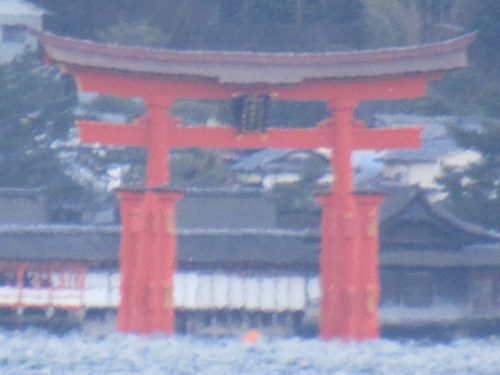
As one can probably imagine, I was more than psyched to finally see an unobstructed torii, so much so that I was antsy to take pictures of it before even boarding the ferry. The photo above was taken from Miyajimaguchi pier at 100x digital zoom on my camera; it somewhat resembles an oil painting more than a photograph, but that just might enhance the fantastic aspect of the reconstructed torii. I could’ve gone on any Saturday that month, but specifically chose the 28th—the final day—because that was the only day they had kagura performances in addition to the usual market and fireworks.
Pier-ing at the Market

I got off the ferry and was greeted by these signs in the plaza advertising the “Miyajima Night Market” and providing valuable information such as the dates and times of events, as well as the names and locations of participating businesses. There were tents (indicated by red and green rectangles) selling food and handcrafted wares beyond the sign, and food trucks whipping up Hiroshima specialties with a twist lined up by the seawall (represented by yellow rectangles). In between all of that was a wide space where people mingled, warmed up with hot bites and beverages, and took photos with the resident deer and a black cattle mascot representing Kitahiroshima Town up north.

One of the food trucks that garnered the most attention was one that sold “ageoko,” which can be summarized as a pocket-sized, deep-fried okonomiyaki with one of a handful of flavors inside: plain soba, cheese, squid, oyster, and the flavor of the day, which was saucheese (sausage and cheese). This was a concept hard for even us Hiroshimarians to understand as this vendor might have been the first to sell such an item, so a sign was placed in front of the truck to explain the Miyajima-exclusive snack. Since I always crave oysters on Miyajima this time of year and knew I wouldn’t be able to make it to the Oyster Festival in February, I figured that the oyster flavor would be best for me and bought myself one.
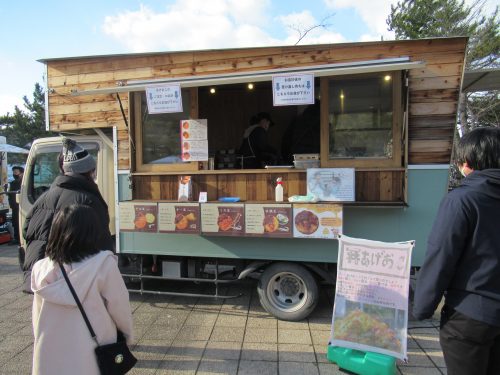
When I got my food, the first thing I did was put distance between myself and the deer, who are notorious for snatching edible and paper items from unsuspecting tourists. I positioned myself outside the ferry terminal building opposite the restrooms where no deer or humans would approach me before digging in. The ageoko was a starchy disc of batter and soba noodles, basted with Otafuku sauce and sprinkled with fine, green seaweed flakes. There seemed to be a single dried oyster in the middle, but I could barely taste it and it was far from enough to satisfy my craving for the delicacy.
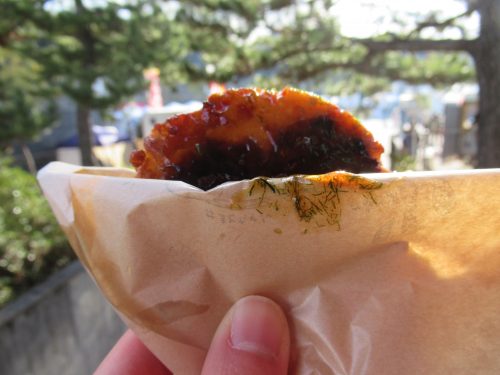
I followed that culinary experiment with a recipe more well-known worldwide: a cup of oyster chowder. Besides being well-seasoned, this soup exceeded my exception due to the sheer number of oysters in this cup alone. I counted as many as five as I was eating, but honestly, I was so engrossed in the bounty of the chowder itself that I might have lost count.
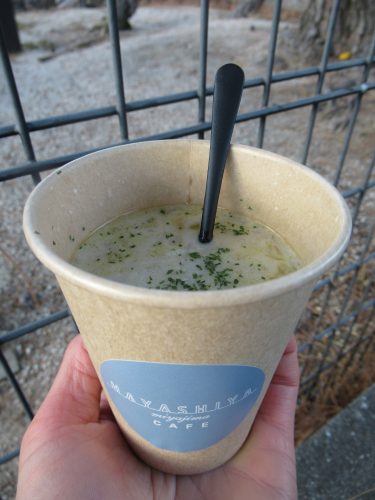
Love Up North!
Will my appetite sated for the time being, I proceeded to the stage just past the food trucks to catch the next kagura performance. Before that started, however, there was a woman on stage with two cattle mascots to promote the town of Kitahiroshima, where the kagura troupe is based, with a song and dance choreography. It was a high-energy routine, but so much movement was indeed necessary to combat the chilly winds and occasional snow that day. Members of the audience near the front could also notice that one of the kagura actors in a demon mask was also dancing along to the music, an act that was described by onlookers as kimokawaii (キモカワイイ – cute, but in a creepy kind of way). After the dance number, the woman talked about Kitahiroshima being a charming place to visit for a number of reasons, but mostly for kagura. I could tell that they were pushing hard to get the name Kitahiroshima out there, through the catchphrases of kita ni koi, a double entendre that means both “come up North (キタに来い)!” and “love in the North (キタに恋)!”
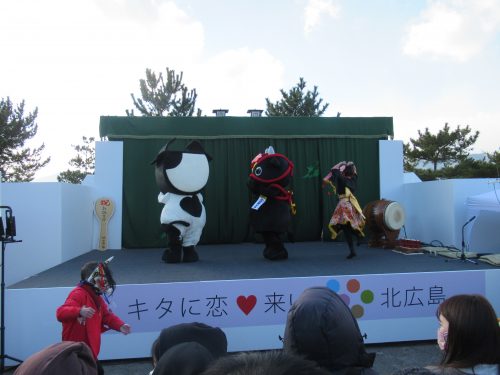
After that, it was finally time for the kagura troupe to make their appearance, and in spite of the biting cold, the musicians still had the gall to wear nothing but a single, thin layer of clothing, all for the sake of tradition. Thankfully, the performers in costume wore heavier things and were never stationary for long, so I wasn’t as worried about them. The show I saw that afternoon was called “Takiyashahime,” a story about a woman who seeks a mystical object and transforms into a demon that must be slain.
Unlike most other kagura stages, which were somewhat closed with a ceiling from where streamers and other objects dropped during the show, this stage was open, meaning that everyone on stage was more susceptible to the elements, and that the audience may have felt more like they were a part of the action. The common fog effect came out of the back of the stage as usual, and the performers themselves shot streamers onto the stage during fight scenes, and multiple times at that. This performance was actually the second of four different shows that the Yama-oh kagura troupe would put on that day; the remaining two would start at night in order to accommodate the fireworks that would happen after sundown.
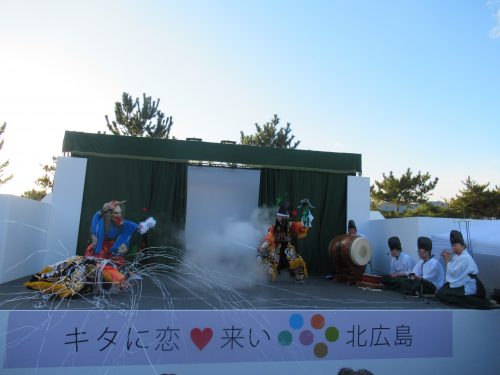
Waiting For the Main Event
When the kagura show ended, there was only one more thing everyone on Miyajima wanted to see, but almost two hours before it would begin. In order to kill time, I walked up and down the Omotesando shopping street, popping in and out of shops, all of which were stuffed with queues despite them almost closing. The overwhelming throng of people waiting turned me off from purchasing any other snacks, and I didn’t want to be late to nab an optimal viewing spot of the fireworks, so it was just a lot of pacing and trying not to get bumped into as I tried to run out the clock. Naturally, an event as anticipated as this one was bound to get crowded and disorderly, so the local police were also patrolling Omotesando right before the start of the fireworks; being physically close to the cops also made me feel safer from any chaos that might otherwise ensue in this area.
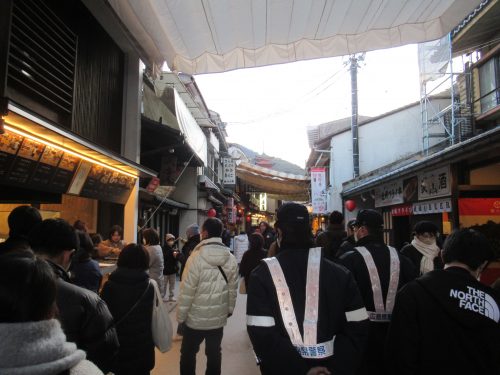
At approximately 5:15 p.m., I returned to the site of the torii to find a queue beginning to form at the entrance to the Itsukushima Shrine building. I hadn’t even realized that it was possible to view the fireworks from within the shrine, but the man holding up the sign couldn’t have been any clearer, so I got in line as soon as I could. We had to wait until it was almost 6:00 p.m. before we would be allowed into the shrine, and part of me prayed I could nab a spot where my vision wouldn’t be blocked by too many things.
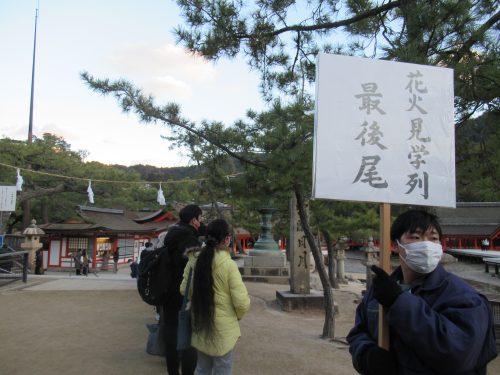
Meanwhile, the tide was receding, slowly but surely, which meant that watching the fireworks display from sea level was also an option. I was only in that queue for about thirty minutes, but the bitter cold made it feel like an eternity and I tried to keep my body mobile to take my mind off of the fact that I was freezing even while the sun was up. When 5:45 p.m. rolled around, the queue was finally let into the shrine, and I frantically walked to the lookout point with the bronze lantern to secure a place for myself with minimal obstructions.
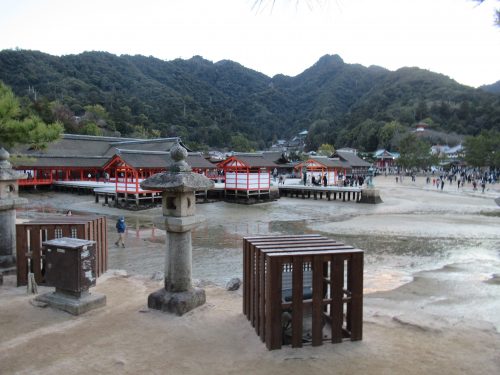
Initially, I thought I was too late when I reached that lantern, but after squeezing through the crowd and inadvertently sitting on the stone block before the lantern (the only space I could stay long-term and not get squashed) I realized I had obtained the best spot out of anyone there. I felt a little guilty being the only one seated, but if it were truly forbidden, somebody would have warned me at some point. All I had to do now was wait for the show to begin, but as my numb, popsicle fingers were struggling just to hold my camera, simply being on standby was a tribulation on its own.
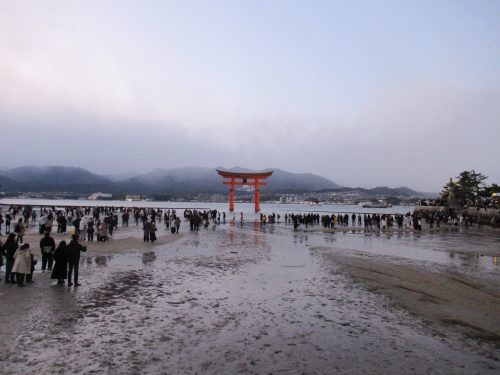
A minute or two after the clock struck 6:00 p.m., the first fireworks were shot into the sky. They all seemed to be coming from a single boat in proximity to the torii, and although we were all amazed by the brilliant explosions lighting up the sky, no one around me spoke during the show, no doubt due to being speechless in awe. The fireworks only got better as time went on, with the biggest blasts rendering the torii nigh invisible from sheer brightness.
Moment of Joy: Best Seat in the House
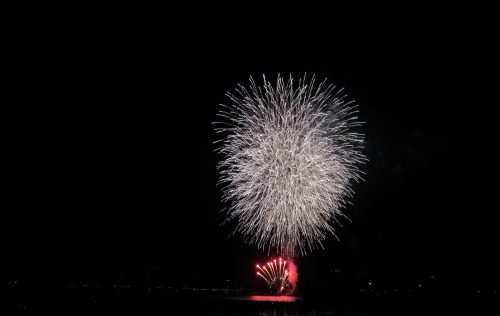
My seat was at the forefront of the lookout point, and although the hundreds of others watching from the dried-up bay were closer to the fireworks than I was, being elevated meant that no one else got in my way, and having a seat is a luxury not many others had during the spectacle. As someone who had never seen the Miyajima Fireworks Festival during the summer due to always being away during Obon, this magical moment was overdue for me. The six minutes or so that the show lasted warmed my heart in the dead of winter, and for most of the fireworks display, I put away my camera and simply enjoyed the spectacle with my eyes. I could think of no better way to celebrate the end of the construction on Itsukushima Shrine than with what might be the last fireworks display that will happen on Miyajima for decades.
The Rest of the Night

Shortly after the fireworks ended, almost all the spectators made a beeline for the ferry terminal, with only a few like myself sticking around to take nocturnal photos of the shrine that we entered for free. Both JR and Matsudai had serpentine lines for their ferries, but as I was anxious to return home, I bit the bullet and took a gamble on Matsudai having a shorter and quicker queue. It was at this point that I realized that some of the restaurants on this island commanded advantageous views of the bay and allowed diners to stay to watch the fireworks from inside, which would have been desirable too. Tourists who would rather wait for the ferry lines to die down also had the option of rejoining the Night Market and watch the last kagura performances before the event officially ended at 8:00 p.m.

While it is a bit saddening to realize that the summer fireworks have ended for good and that these winter fireworks were a one-time deal, I was still grateful to have been a witness to this historic celebration. In addition, I’m elated to see Miyajima returning to its 2019 state in terms of appearance and tourists, and things will only get better as the weather gets warmer. The promotions and kagura shows I saw at the Miyajima Night Market have now got me wanting to visit Kitahiroshima to see a kagura troupe perform on their home turf and try some local cuisine. Tourists who come to Miyajima now may not have the chance to see fireworks anymore, but at least the retouched torii is more beautiful than it had been in decades, and during their visit to the Miyajima of tomorrow they may discover another wonderful side of Hiroshima Prefecture we past visitors never saw!
Written by the Joy in Hiroshima Team
